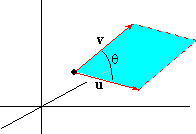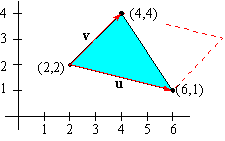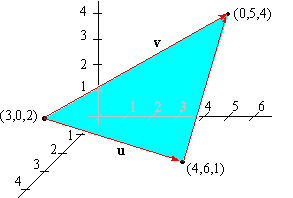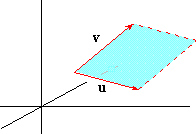Part 3: Parallelograms and Triangles
Given two vectors u and v with a common
initial point, the set of terminal points of the vectors su+tv for 0 £ s,t £ 1 is defined to be parallelogram
spanned by u and v.
We can explore the parallelogram spanned by two vectors in a 2-dimensional coordinate system. That is, because coordinate systems are a figment of our collective imaginations, we can imagine
the parallelogram spanned by two vectors as being in an x' y' coordinate system, where the x'-axis is parallel to u
and the y'-axis is in the same plane as u and v.
|
|
| (Click and drag arrow's endpoint. Angles are in degrees.) |
|
Since u = || u || i and v = || v|| ( cos( q) i + sin( q) j) in the x' y' coordinate system, their cross product is
|
|
|
|
|| u|| || v|| ( cos( q) i×i + sin( q) i×j) |
|
|
|
|
|
|
This results in the following theorem:
Theorem 3.3: If q is the angle formed by u and v, then
|
|| u×v|| = || u|| || v|| sin(q) |
 |
|
Let 's consider two applications of Theorem 3.3. First, if u and
v are parallel, then q = 0 and u×v = 0.
Second, the parallelogram spanned by u and v can be cut into two
parts which form a rectangle with height || v|| sin( q) and base || u|| ,

Thus,
the area of the parallelogram formed by u and v is || u|||| v|| sin( q) . Indeed, we have the following:

The latter result follows from the fact that u-v bisects the
parallelogram formed by u and v.
EXAMPLE 5 Find the area of the triangle with vertices at P1( 2,2) , P2( 4,4) , and P3(6,1) .

Solution: It is easy to see that u =
á2,2
ñ and v =
á 4,-1
ñ . As
vectors in R3, we have u =
á2,2,0
ñ and v =
á 4,-1,0
ñ .
Thus, their cross product is
Since the triangle has half of the area of the parallelogram formed by u and v, the area of the triangle is
|
Area = || u×v|| = |
|
 |
|
| 02+02+(-10) 2 |
|
= 5 units2 |
|
EXAMPLE 6 Find the area of the triangle with vertices P1( 3,0,2) , P2( 4,6,1) , and P3(0,5,4) .

Solution: To do so, we first construct the vectors u and
v:
|
 |
|
| u = |
P1P2 |
=
á4-3,6-0,1-2
ñ =
á 1,6,-1
ñ |
|
 |
|
| v = |
P1P3 |
=
á0-3,5-0,4-2
ñ =
á -3,5,2
ñ |
|
As vectors in R3, we now have u =
á2,2,0
ñ and v =
á 4,-1,0
ñ .
Thus, their cross product is
|
|
|
| |
|
|
á 6·2-5·( -1) ,( -1) ·( -3) -2·1,1·5-( -3) ·6
ñ |
| |
|
|
|
Since the triangle has half of the area of the parallelogram formed by u and v, the area of the triangle is
|
Area = || u×v|| = |
|
 |
|
| 172+22+232 |
|
= 14.335 units2 |
|
Check your Reading: What is the area of the parallelogram spanned by u
and v in example 6?










